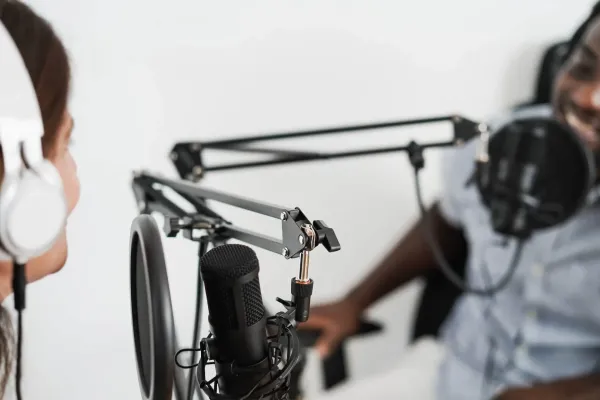
 Details
Details
PodCCCCasting... Oops! Did someone just fall asleep at their keyboard, or is there a reason for that flurry of Cs? Well, we’re going to take a look at how to avoid some of the most common mistakes in podcasting, and those four Cs will all come into play.
But first, let’s start with the basics. Podcasts are a highly effective medium for native advertising. A great podcast engages its audience by being relevant and credible. For native advertising to work in podcasting, it needs to be embedded naturally. If this can be achieved in a non-intrusive way, coupled with an authoritative host and fascinating guests, it’s pretty well guaranteed to reach and satisfy the target audience.
I’ve made the case for this in previous posts, backed by solid research from Ipsos and the University of Antwerp.
→ RELATED ARTICLE: Podcasts deliver – for listeners and native advertisers
But here’s the thing: it doesn’t always work. There are a number of ways that both podcast publishers and native advertisers can get it wrong. This brings us back to those four Cs, the essentials that make the difference between a good podcast… and a great one.
The first C of podcasting: Concept
We will start with CONCEPT, which may seem obvious, but can easily be overlooked.
We’re all kids at heart and we like to be engaged by a great story. Great stories have a beginning, a middle and an end. Great stories have character – and characters. “Hey, I heard this podcast the other day… it was some people talking about something.” Does that recommendation fire your imagination? Unlikely, but what about this: “Hey, I heard this podcast the other day… some reporters were inside a rubbish cart, talking about using data to fight illegal dumping.” Now that is a concept.
What’s more, it’s an example of a real native podcast from EY built around the theme of demonstrating how ‘digitisation’ is more than a buzzword. Digitisation can, for example, make your city cleaner. Together with EY, waste manager Ivago developed a solution in Ghent that can tackle illegal dumping faster and more efficiently.
An important subject that could have been presented in a way that was as dry as a Ghent dustcart, but instead found a storytelling line that was entertaining and engaging.
The second C of podcasting: Context
The CONTEXT of the podcast is the next of the four Cs to consider. Regardless of the medium, few people respond well to having messages almost subliminally introduced to them. Do we want our international news feed brought to us with overt advertising from a toothpaste manufacturer, for example? Do we want breaking news stories interrupted by instructions on correct dental hygiene?
We live in a world where sponsorship is an essential part of funding programmes, but listeners will immediately notice if something about a podcast is out of place, whether within the content itself or in how the podcast is presented.
It’s important to ensure that a podcast is true to its context by being completely transparent about how and why the podcast has been created and released. In other words, do not try to ‘smuggle’ messaging into the piece, or go in ‘under the radar’. The moment a listener starts to suspect they are being manipulated is the moment they will start to disconnect. So from the get-go, be upfront about who is behind the podcast, and what their values are.
Transparency in the context of your podcast is intimately connected with authenticity. Your DNA, both of the brand and the ecosystem it operates in, must be aligned and clearly understood by the listener. No ‘ifs’, no ‘buts’ and no doubt – you must own the context.
The third C of podcasting: Community
Following on from the first two Cs brings us to COMMUNITY, which every podcast must develop. No community means you are likely to be podcasting into thin air. No one wants that, so to be successful you’ll need a community of loyal listeners. But how and where to get started with that? Can you use that Apple podcast thing, or Spotify, and isn’t there something from Google for podcasters?
The answer is yes, these channels all do a good enough job of distributing your message. But getting your podcast online is not the end goal; it is just the beginning.
Leveraging your own channels and audience is the way to success. Use your own ecosystem to spread the word that you are now podcasting. If there are people who are already familiar with your brand and know what qualities it stands for, then tell them about your new offering. Use banners in related content, newsletters and social media to draw the attention of your existing community and to extend beyond it.
Think wide here and figure out who you might be able to partner with to create synergy and strengthen opportunities for mutual gain by also using their comms channels. But of course, just as you must stay true to your own DNA, ensure that your partners’ ecosystems match yours and that they accurately communicate your message through their own channels.
Creating a community is not a ‘do it once then forget about it’ job. Constant care and attention are needed to create and maintain the community, and to grow it. This means always ensuring that you communicate before the release of the podcast, promote it while it’s current, and continue to do so afterwards. The very nature of podcasts means that their availability and ‘shelf life’ can be long-lasting, so keep the awareness of your community focused on all of your offerings.
The fourth C of podcasting: Creativity
And the last of the four Cs – need you ask? It’s CREATIVITY, of course. Creativity must underpin everything about the podcast – from the concept and context to growing a community. Creativity also applies to your approach to advertising within the podcast.
You want native advertising to spark interest and be recognised without being intrusive. No advertiser wins points for annoying their audience. So how to be creative in your audio strategy to take the podcast to the next level? Here are three ideas to spark the creativity of your podcast team.
Three tips to get creative
Bannering with audio teasers gives your audience a sneak-peak of the podcast. Just as it’s now hugely popular and effective for streaming platforms to provide teaser clips of upcoming series episodes, you too can whet the appetite of listeners by providing a visual trailer, coupled with audio of a significant moment – a soundbite.
Native advertising is often the background purpose of many podcasts. But it has to be seamlessly embedded in the podcast and be closely related to the brand values. Take for example the way in which the EY message is stitched into the Start to the Metaverse podcast, where ‘De Tijd takes you to the Brave New World of the Metaverse. We explore what it is, what opportunities lie there and what we need to watch out for.’
We think of podcasting as a listening experience, but what about using the creative approach to also make it a reading experience, for those who might sometimes prefer to browse through a piece, and step back to re-read a point? There’s no rule that says a podcast can ‘only’ be a podcast – think creatively to engage with the needs of your audience and do everything you can to win their attention, and keep it. Here is a somewhat technical subject that could benefit from the dual ‘read it/hear it’ approach.
A fifth C?
Podcasting is one of the most powerful and appreciated media currently available, which offers a highly effective way to embed native advertising into the flow of the content. Get the concept and context right, build the community, and be creative in how your native advertising is presented. But let’s end by adding a final C for credibility, because that wraps up all the other notions. Hit the other ‘Cs’, and your podcast will be credible. Credibility means your audience will find your podcast and keep returning for more, absorbing your native advertising without any sense of annoyance. That's the beauty of Podcccccasting.





